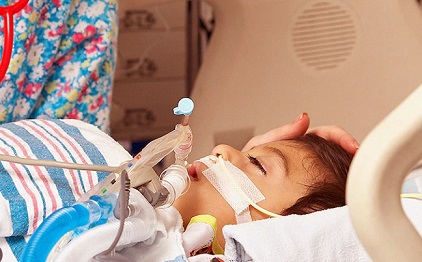Nikhil Prasad Fact checked by:Thailand Medical News Team Oct 28, 2024 10 months, 2 weeks, 1 day, 18 hours, 22 minutes ago
Medical News: A new study conducted by researchers from Mansoura University in Egypt has provided a closer look at how COVID-19 impacts iron levels in children. Led by Dr. Mai S. El-Meshad, Dr. Angi Adel Alwakeel, Dr. Reham M. El-Farahaty, and Dr. Mayada S. Zeid, the study focused on 49 children between 1 month and 18 years old who were diagnosed with either acute COVID-19 or the related condition known as multisystem inflammatory syndrome in children (MIS-C). The findings shine a light on the impact of COVID-19 on children’s iron metabolism, revealing a significant drop in iron and hemoglobin levels among infected patients.
 Iron Deficiency Observed in Pediatric COVID-19 Cases
Unveiling the Study Findings
Iron Deficiency Observed in Pediatric COVID-19 Cases
Unveiling the Study Findings
This
Medical News report highlights the findings from blood tests taken both during infection and three months after recovery, revealing iron deficiency anemia in all patients. While both groups saw improvements after recovery, the effect was more pronounced in those with MIS-C, a severe inflammatory response tied to COVID-19. Notably, one of the most telling biomarkers in this study was the level of soluble transferrin receptors (sTfR), which were significantly lower in children who did not survive. This biomarker showed potential for distinguishing survival outcomes, as the study found that an sTfR level below 18 nmol/L could increase mortality risk nearly six-fold.
Understanding the Iron Deficiency Mechanism
Iron is a crucial element for immune function and energy production within cells, making it essential for combating infections like COVID-19. However, COVID-19 may disrupt iron regulation, with the virus increasing levels of ferritin - a protein that stores iron - while decreasing iron availability in the bloodstream. This disruption can lead to iron deficiency anemia, wherein cells struggle to transport enough oxygen, which may contribute to the severe organ damage seen in some COVID-19 cases.
The study explained that the imbalance in iron levels, often linked with higher ferritin, is a marker of severe inflammation. Researchers noted that inflammation-driven iron depletion, a condition seen across many infections, appears heightened in COVID-19, likely due to the body's attempts to reduce iron availability to the virus.
Methods and Patient Grouping
The research involved 49 children divided into two groups: 36 with acute COVID-19 and 13 with MIS-C. They were evaluated based on clinical severity and disease outcome, which included mild, moderate, and severe to critical cases. The researchers measured several iron-related biomarkers, including hemoglobin, mean corpuscular volume (MCV), mean corpuscular hemoglobin (MCH), reticulocyte hemoglobin (RET-He), and soluble transferrin receptors.
The study took place at Mansoura University Children’s Hospital and followed strict protocols to ensure the safety and accuracy of data. The follow-up data, gathered three months after recovery, indicated improvements in hemoglobin and iron levels, with ferritin levels decreasing back to normal in most children,
particularly in those recovering from MIS-C.
Disease Severity and Mortality Risk
The analysis demonstrated a strong correlation between low sTfR levels and higher mortality rates, especially in patients with severe iron deficiency anemia. Children in the severe to critical category displayed significantly higher mortality rates, with eight out of 23 children in this category not surviving. The study highlighted that an sTfR level below 18 nmol/L serves as a valuable predictor, capable of distinguishing between patients with higher and lower survival chances with 82.5% specificity and 66.7% sensitivity.
Interestingly, children with MIS-C showed more prominent signs of iron deficiency anemia than those with acute COVID-19, reinforcing the idea that MIS-C triggers a heightened inflammatory response, leading to acute decreases in hemoglobin. These results underscore that the level of iron-related biomarkers, such as sTfR, could be instrumental in predicting disease outcomes and tailoring treatment approaches.
Conclusion
The study's findings emphasize that COVID-19-induced iron deficiency anemia poses a notable risk for pediatric patients, particularly those suffering from MIS-C. Identifying sTfR as a survival marker presents a valuable diagnostic tool that could enhance how clinicians assess and manage severe COVID-19 cases in children. Given the observable recovery in iron status post-infection, the study encourages healthcare providers to closely monitor iron levels in pediatric COVID-19 patients and consider iron supplementation as part of the recovery process. However, further research involving larger pediatric samples and longer follow-up periods is needed to solidify these recommendations.
The study findings were published in the peer-reviewed journal: Egyptian Pediatric Association Gazette.
https://link.springer.com/article/10.1186/s43054-024-00330-x
For the latest COVID-19 News, keep logging on to Thailand
Medical News.
Read Also:
https://www.thailandmedical.news/news/genetic-factors-linked-to-severe-covid-19-in-children
https://www.thailandmedical.news/news/uncovering-the-role-of-gut-permeability-in-mis-c-a-new-insight-into-pediatric-covid-19-complications
